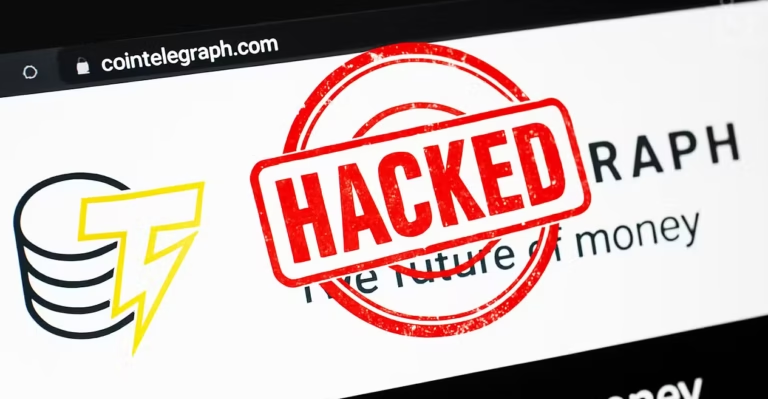Cointelegraph hack community was alarmed when revealed on June 23, 2025, that a sophisticated front-end exploit had compromised its website. The attack was aimed at fooling users into connecting their cryptocurrency wallets to claim bogus token airdrops, showing how crypto-phishing scams have evolved.
The breach represents a significant security incident affecting one of the most trusted sources of cryptocurrency news and information. Visitors to the Cointelegraph website encountered malicious pop-ups that falsely claimed to offer “CoinTelegraph ICO Airdrops” or “CTG tokens” as part of what appeared to be a legitimate promotional campaign.
How the Attack Unfolded
The pop-up falsely claims users have been selected for a giveaway of a new token, purportedly part of a “fair launch initiative” by Cointelegraph to reward loyal readers. The fraudulent interface was designed to appear authentic, complete with professional branding that mimicked Cointelegraph’s legitimate design elements.
The malicious pop-up displayed fabricated token pricing information and promised users approximately $5,500 worth of tokens if they connected their cryptocurrency wallets to the platform. To add credibility to the scam, the attackers even claimed that a renowned blockchain security firm, CertiK, had audited the smart contract, despite this being entirely false.
The attack mechanism involved injecting malicious code into Cointelegraph’s front-end infrastructure, allowing the fraudulent pop-ups to appear seamlessly integrated with the legitimate website. This type of attack is hazardous because it exploits users’ trust in established platforms, making it difficult for even experienced crypto users to identify the threat immediately.
Cointelegraph’s Response and User Warnings
Upon discovering the breach, Cointelegraph quickly issued a public warning through their official social media channels. The company’s alert was clear and direct, advising users to avoid clicking on the suspicious pop-ups, connecting their wallets, or entering any personal information through these fraudulent interfaces.
The news outlet confirmed that their security team was actively working to resolve the issue and remove the malicious code from their website. This rapid response demonstrates the importance of having robust incident response procedures in place, particularly for platforms that serve as trusted sources of information in the cryptocurrency space.
If users accidentally interact with the malicious interface, they should check their wallet activity and transfer funds to secure wallets. The company stated that valid airdrops and token distributions would utilize proven channels.
Cryptocurrency Platform Attacks Escalate Phishing Sophistication
The Cointelegraph incident was not an isolated event but rather part of a coordinated wave of similar attacks targeting major cryptocurrency platforms. Just two days before the Cointelegraph breach, popular price aggregator CoinMarketCap experienced a remarkably similar front-end exploit.

In the CoinMarketCap attack, visitors encountered pop-ups requesting wallet connections for alleged verification purposes. The platform later confirmed that malicious code had been successfully injected into their website infrastructure before being detected and removed. The similarity in attack methods suggests that the same threat actors may be responsible for both incidents, or that successful attack vectors are being quickly replicated across the crypto ecosystem.
These coordinated attacks represent a significant escalation in the sophistication of crypto-related phishing schemes. Unlike traditional phishing attempts that rely on fake websites or malicious emails, these attacks compromise legitimate, trusted platforms to serve malicious content directly to users who believe they are interacting with authentic services.
The Growing Threat of Front-End Exploits
Front-end exploits represent a particularly insidious form of cyberattack because they exploit the trust relationship between users and established platforms. When users visit a website they trust, they naturally assume that all content and pop-ups are legitimate, making them more susceptible to social engineering tactics.
The attacker drains victims’ wallets after they connect them under the guise of receiving tokens or confirming their identity. The sophistication of these attacks has increased dramatically, with threat actors now capable of injecting malicious code that appears seamlessly integrated with legitimate website interfaces.
Targeting major cryptocurrency platforms is crucial because they attract individuals who are already seeking digital assets and possess substantial wallet balances. Free tokens work because consumers react to actual airdrops in cryptocurrency.
Impact on the Cryptocurrency Industry
The Cointelegraph and CoinMarketCap attacks have sent shockwaves through the cryptocurrency community, raising serious questions about the security of even the most established platforms. These incidents highlight the need for enhanced security measures and user education to combat increasingly sophisticated phishing attempts.

According to blockchain intelligence firm TRM Labs, phishing schemes and malware-based infrastructure attacks made up 70% of the $2.2 billion stolen in crypto-related Cointelegraph hack in 2024. This statistic highlights the magnitude of the threat facing cryptocurrency users and underscores the importance of implementing robust security measures across the entire ecosystem.
The attacks also demonstrate how threat actors are adapting their methods to exploit the trust relationships that exist within the cryptocurrency community. By compromising established platforms rather than creating entirely fake websites, attackers can leverage the reputation and user base of legitimate services to maximize the impact of their schemes.
Protecting Yourself from Similar Attacks
The Cointelegraph incident serves as a crucial reminder for cryptocurrency users to remain vigilant, even when interacting with trusted platforms. Several key principles can help protect against similar attacks in the future.
First and foremost, users should exercise extreme caution when encountering unexpected pop-ups or prompts requesting wallet connections, especially those promising free tokens or airdrops. Legitimate platforms typically announce such promotions through official channels well in advance, and users should always verify the authenticity of any airdrop through multiple sources before participating.
When encountering any request to connect a Cointelegraph hack wallet, users should carefully examine the URL and interface for any signs of tampering or unusual behavior. Even on trusted websites, it’s advisable to navigate away and return to the site through a fresh browser session if anything appears suspicious.
Users should also consider using dedicated browsers or browser profiles for cryptocurrency activities, enabling additional security features such as pop-up blockers and script restrictions. Hardware wallets provide an extra layer of security by requiring physical confirmation for transactions, making it more difficult for attackers to drain funds even if users inadvertently connect to malicious interfaces.
Industry Response and Future Implications
The Cointelegraph hack industry has responded to these attacks by increasing its focus on security measures and user education. Many platforms are implementing additional verification steps for wallet connections and reviewing their front-end security protocols to prevent similar compromises.
Security firms and blockchain analysts are also working to identify and track the threat actors responsible for these attacks, to disrupt their operations and prevent future incidents. Following the latest attacks, the cryptocurrency community’s collaborative approach to addressing security concerns should continue to detect and mitigate potential dangers.
The incidents have also sparked discussions about the need for industry-standard security protocols and best practices for cryptocurrency platforms. As the ecosystem continues to mature, establishing comprehensive security frameworks will be crucial for maintaining user trust and preventing similar breaches.
Conclusion
The Cointelegraph website hack represents a significant escalation in the sophistication of cryptocurrency-related phishing attacks. By compromising trusted platforms and exploiting user trust, threat actors are devising new methods to steal digital assets and sensitive personal information from unsuspecting victims.
In 2024 and 2025, fake airdrop scams targeting Hamster Kombat and others resulted in over $1 billion in losses, contributing to more than $ 9.9 billion in global crypto scam damages. These statistics underscore the pressing need for enhanced security measures and increased user awareness in the cryptocurrency sector.

